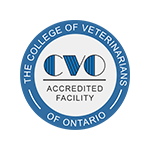
Separation anxiety is a common behavioural problem in dogs. The signs are all too familiar to those dedicated pet owners whose pets are a little too attached! Dogs with separation anxiety will:
– Pace, pant, whimper, or cry as the owner is preparing to leave
– Deprive themselves of food when they are home alone
– Become destructive when home alone, and may chew, scratch, or generally destroy just about anything – however, there is often a focus on barriers like windows and doors
– Have accidents in the house
– Bark, whine, or howl when left alone
Ask any person living with a dog that fits the description above and they will tell you – its not easy! Luckily, there are some steps that anyone can take to try to reduce separation anxiety in dogs.
- Reduce your dog’s dependence on you
– Dogs need to learn how to be independent in order to cope with alone time
– When you are home, prevent your dog from clinging close to you. Set up barriers if necessary so that your dog learns to relax apart from you. Reward calm behaviour.
– Don’t allow your pet to sleep in your bed or bedroom
– Provide toys or treats that occupy your dog’s time (even if you are home) to teach your dog that independent time can be rewarding. For example, you can provide a rawhide chew, Kong toy stuffed with canned food and frozen, or treat dispensing ball
– Involve other family members in the care of your dog to reduce your dog’s feeling of dependence on one person
- Reduce you dog’s sensitivity to your leaving and excitement with your returning
– Dogs with separation anxiety begin to learn your body language indicating you are leaving and this can ramp up their anxiety
– By performing as if you are leaving when you are not, your dog will begin to lose the association and not be as sensitive to the prelude to your departure
– At various, unpredictable times throughout the day, go through your routine as if you are leaving (shower, grab your jacket, keys, purse, etc) and walk out the door, then return seconds later.
– Once you can do this without your dog becoming upset, increase the time before you re-enter the home.
– It is also helpful to reduce your dog’s anticipation to your return. When arriving home, avoid exuberant greetings! Instead, initially avoid interaction with your dog until he is calm.
- Additional Calming Tools
– Save a favourite treat or toy that you only allow your dog to have when you’re away (just make sure you can safely leave the item with your dog)
– Sometimes leaving a television or radio on can help sooth anxious dogs
– The product Adaptil (www.adaptil.com) contains Dog Appeasing Pheromone. This pheromone is an odorless molecule that communicates to dogs that they are in a safe environment. It is available as a plug in diffuser, spray, or collar.
– Thundershirts (www.thundershirt.com) are snug fitting shirts for dogs (and cats!) that provide a sense of security in some anxious dogs similar to a baby wrapped up in a swaddle
– For more severe cases, behavioural medication may be needed (temporarily or longer term) to help dogs succeed with a anxiety management program. Speak with your veterinarian for more!
Separation anxiety takes lots of time and dedication to manage. However, it can be successfully controlled by taking the right steps – so don’t give up! We’re here to help you on your journey. Don’t hesitate to book a consultation to discuss your dog’s anxiety problems!



